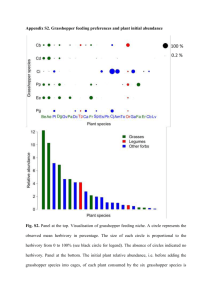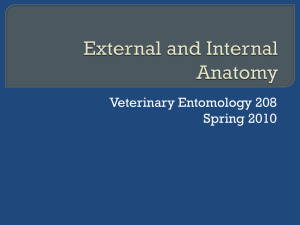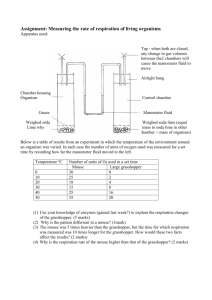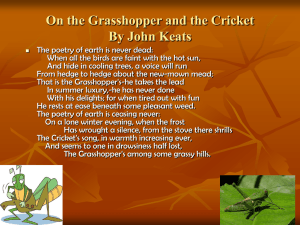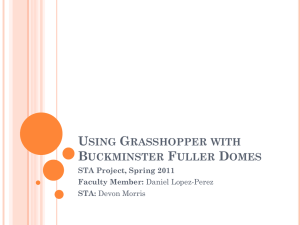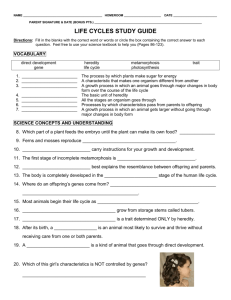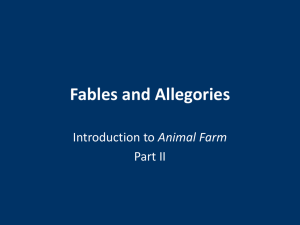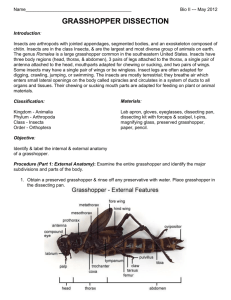Grasshopper Dissection Lab
advertisement
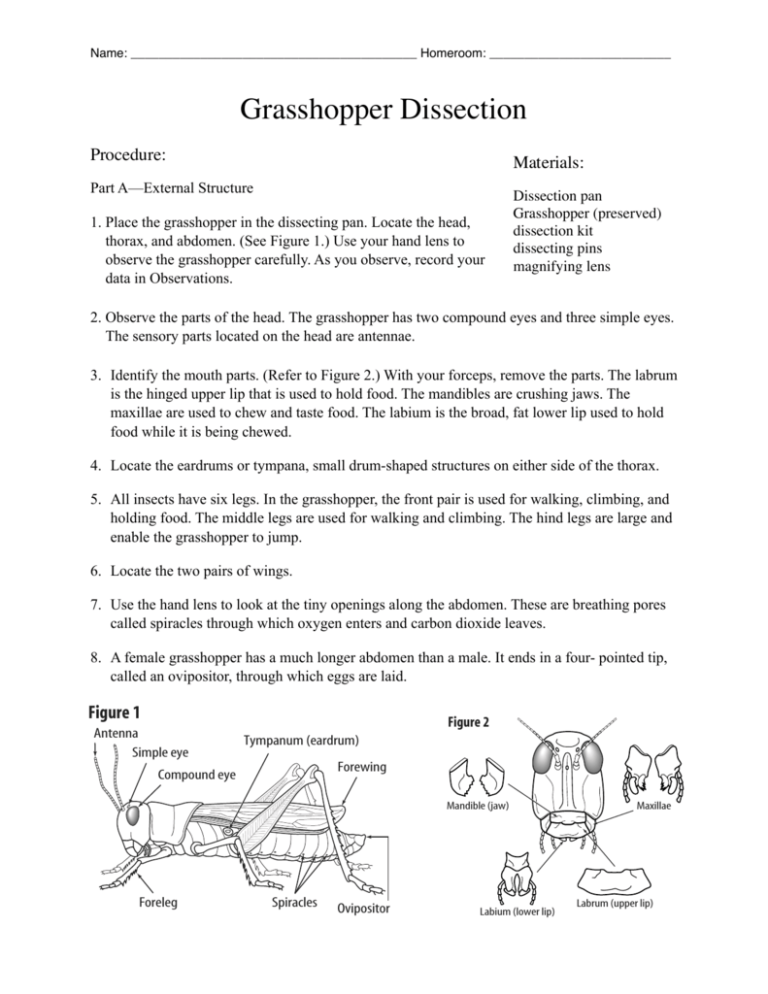
Name Date Class Name: _________________________________________ Homeroom: __________________________ 2 Laboratory Activity Grasshopper Anatomy Grasshopper Dissection A grasshopper is well adapted to its way of life. Its features are representative of the insect group. A grasshopper is large enough that its features can be seen easily. Procedure: Materials: Strategy Part will A—External Structure You observe and identify the specialized body parts of the grasshopper. Dissection pan You will examine and identify the internal structure of the grasshopper. Grasshopper (preserved) 1. Place the grasshopper in the dissecting pan. Locate the head, Materials thorax, and abdomen. (See Figure 1.) Use your hand lens to dissection kit dissecting pins magnifying lens dissecting observe pan the grasshopper carefully. As you observe, record your grasshopper (preserved) data in Observations. hand lens forceps 2. Observe the parts of the head. The grasshopper has two compound eyes and three simple eyes. dissecting scissors The sensory parts located on the head are antennae. Figure 2 Procedure 3.443G-1-54-mss02-827205 Identify the mouth parts. toimpos05 Figure 2.) With your forceps, remove the parts. The labrum 3/26/04 2:30(Refer PM Page 13 301:goscanc:scanc443:layouts: Part A—External Structure is the the hinged upper lip that is used to holdpan. food. The mandibles are crushing jaws. The 1. Place grasshopper in the dissecting maxillae usedthorax, to chewand and abdomen. taste food. The labium is the broad, fat lower lip used to hold Locate thearehead, food Figure while it1.) is being chewed. (See Use your hand lens to Name Date Class observe the grasshopper carefully. As you Mandible (jaw) Maxillae 4. observe, Locate the eardrums tympana, small record yourordata in Data anddrum-shaped structures on either side of the thorax. Observations. Grasshopper Anatomy 5. All insects have six legs.Laboratory In the grasshopper, the front pair is used for walking, climbing, and 2. Observe the parts of the head. The Activity holding food. The middle legs are used for walking and climbing. The hind legs are large and grasshopper has two compound eyes and enable the grasshopper to jump. A grasshopper is wellparts adapted to its way of life. Its features are representative of the insect three simple eyes. The sensory group. A grasshopper is large enough that its features can be seen easily. on two the head arewings. antennae. 6. located Locate the pairs of Strategy Labrum (upper lip) 3. Identify the mouth parts. (Refer to Figure 2.) Labium lip) You will observe and identify the specialized body parts of the(lower grasshopper. With your forceps, remove the parts. The 7. Use the handYou lenswill toexamine look at and the identify tiny openings along the abdomen. These are breathing pores the internal structure of the grasshopper. labrum is the hinged upper lip that is used to 4. Locate theleaves. eardrums or tympana, small called spiracles through which oxygen enters and carbon dioxide Materials hold food. The mandibles are crushing jaws. drum-shaped structures on either side of dissecting pan The maxillae are used to chew and taste 8. A female grasshopper a much longer abdomen thanthe a male. It ends in a four- pointed tip, thorax. grasshopperhas (preserved) food. labium is the broad, fat lower hand lens calledThe an ovipositor, through which eggs lip are laid. 5. All insects have six legs. In the grasshopper, used to hold forceps food while it is being chewed. the front pair is used for walking, climbing, dissecting scissors Figure 1 and holding food. The middle legs are used Figure 2 Procedure for walking and climbing. The hind legs are Antenna Tympanum (eardrum) Part A—External Structure Simple eye1. Place the grasshopper in the dissecting pan. large and enable the grasshopper to jump. Forewing Locate Compound eye the head, thorax, and abdomen. 6. Locate the two pairs of wings. (See Figure 1.) Use your hand lens to 7. Use the hand lens to look at the tiny openobserve the grasshopper carefully. As you Mandible (jaw)the abdomen. These Maxillae ings along are breathobserve, record your data in Data and ing pores called spiracles through which Observations. oxygen enters and carbon dioxide leaves. 2. Observe the parts of the head. The grasshopper has two compound eyes and 8. A female grasshopper has a much longer three simple eyes. The sensory parts abdomen than a male. It ends in a fourlocated on the head are antennae. pointed tip, called an ovipositor, through Foreleg 3. Identify the mouth Spiracles Labrum (upper lip) parts. (Refer to Figure 2.) Ovipositor which Labium eggs are (lowerlaid. lip) With your forceps, remove the parts. The vision of the McGraw-Hill Companies, Inc. labrum is the hinged upper lip that is used to hold food. The mandibles are crushing jaws. The maxillae are used to chew and taste food. The labium is the broad, fat lower lip used to hold food while it is being chewed. Hands-On Activities Copyright © Glencoe/McGraw-Hill, a division of the McGraw-Hill Companies, Inc. 2 4. Locate the eardrums or tympana, small drum-shaped structures on either sideAnimals of Invertebrate the thorax. 5. All insects have six legs. In the grasshopper, 13 Name: _________________________________________ Homeroom: __________________________ Part B—Internal Structure 1. Remove the three left legs. Insert the point of your scissors under the top surface of the last segment of the abdomen. Make a cut to the left of the mid-dorsal line. Be careful not to cut the organs underneath. In front of the thorax, cut down the left side to the bottom of the grasshopper. Cut down between the next to the last and last abdominal segments. WARNING: Always be careful with all sharp objects. 2. Use your forceps to pull down the left side. Locate the large dorsal blood vessel. 3. Use your scissors to cut the muscles close to the exoskeleton. Locate the finely branched trachea leading to the spiracles. 4. Cut through the exoskeleton over the top of the head between the left antenna and left eye to the mouth. Remove the exoskeleton on the left side of the head. Find the dorsal ganglion or brain. 5. Cut away the tissue to show the digestive system. Refer to Figure 3 and identify the mouth, esophagus, crop, gizzard, and stomach. Note that the gizzard and stomach are separated by a narrow place. The digestive glands, called gastric caeca, that secrete enzymes into the stomach are attached here. 6. Another narrow place separates the stomach from the intestine. Malpighian tubes, which collect wastes from the blood, are located here. 7. Observe the colon, which enlarges to form the rectum. Wastes collect here before passing out the anus. 443G-1-54-mss02-827205 3/26/04 2:30 PM Page 14 impos05 301:goscanc:scanc443:layouts: 8. In the female, the ovary is located above the intestines. In the male, a series of whitish tubes, the testes, are located above the intestine. Name Date Class 9. WARNING: Give all dissected materials to your teacher for disposal. Always wash your hands after a dissectionActivity procedure. Laboratory 2 (continued) Hands-On Activities Figure 3 Crop Gizzard Gastric caeca Heart Ovary Intestine Rectum Brain Anus Esophagus Mouth Colon Ventral nerve cord Part B—Internal Structure 1. Remove the three left legs. Insert the point of your scissors under the top surface of the last Stomach Malpighian tubes 5. Cut away the tissue to show the digestive system. Refer to Figure 3 and identify the mouth, esophagus, crop, gizzard, and stomach. Note that the gizzard and Name: _________________________________________ Homeroom: __________________________ Observations: Sketch of external parts of grasshopper. May include actual picture of grasshopper. Label antenna, simple eye, compound eye, foreleg, eardrums, forewing, spiracles. Sketch of external parts of grasshopper head. May include actual picture of grasshopper. Label antenna, simple eye, compound eye, mandible, maxillae, labium, and labrum. Name: _________________________________________ Homeroom: __________________________ Sketch of the interior of grasshopper. May include actual picture of grasshopper. Label mouth, brain, esophagus, crop, gizzard, heart, stomach, rectum, anus, and ventral nerve cord. Conclusion: 1. What are the three sections of a grasshopper’s body? 2. Describe the function of the following parts: eyes, antennae, labrum, mandibles, maxillae, labium, eardrums, legs (front, middle, and hind), wings, spiracles, rectum 3. How is a grasshopper’s mouth adapted for plant eating? 4. What is the difference between a grasshopper’s skeleton and yours?
